Signing your player up for high competition soccer can be tricky. Recreational soccer is fun and equal playing time is encouraged. However, the coach is most likely a volunteer father who knows little of the sport and precious developmental opportunities can be overlooked. High competition soccer clubs have capitalized on this opportunity and marketed themselves as an appropriate place for all players: beginners to very experienced.
You may not have the $1500 – $3000 per year to sign your player up for high competition soccer. That price doesn’t include uniforms, tournaments, travel costs, or extra activities your team might do, but you can look into scholarship and financial aid programs that the non-profit clubs offers. Some high competition clubs even work on a sliding scale.
Here’s the first quagmire, though; is your player good enough? Fear not, in some clubs there are 2-5 teams at your player’s age level. That means there may be a place for your player on a lower level team. In many of these clubs they label the skill level by color (gold, blue, black, orange, silver, white) with gold being the most competitive and white being the least. Many players transitioning from a recreational environment start on a white team. However, if a club does not have enough players to form an additional team, they will sometimes form a group of “developmental players.” Watch out for this practice. If your player is labeled as a developmental player, they usually do not get playing time during games. Therefore, you might as well play recreation league or look for a different club.
If you and your player do agree to become a developmental player, it may look something like this: Say twenty-two players are signed up in a single age group, which is not enough to make two full teams, but the club wants your money (times twenty-two). So they may form a developmental group with the extra players. This group will need to fight for a place on the starting team each week. Being that the game is the best teacher, and players at all levels train multiple times each week with the main goal of playing in a game, how appropriate is this practice in a youth environment? How many times will your player’s feelings be hurt throughout the season as they once again are not invited to be on the game roster? If you agree to have your player become a “developmental” player just to expose them to the coach and team environment, then ask if you’ll be charged less as you may not need to contribute to playing card fees, referee fees, league fees, or a uniform in most cases (but perhaps a practice jersey).
Coaches in high competition clubs are being paid. They are professionals that hold licenses; national or international. Although licensing does not necessarily make a good coach, it does speak to the commitment level and professionalism of the coach. Like a teacher, coaches need to keep their skills up. With that said, ask the coach about his or her license(s). When did they get them and from what organization (NSCAA, CYSA)? Do they plan on furthering their development. If so, when?
You are paying a pretty penny, so shop different clubs. What system does the soccer club subscribe to? Many clubs purchase a specific system (Dutch, Italian, Spanish). These systems are usually named after the coach or club that developed them. The cost the club paid for the system literature, equipment, philosophy, and access to websites is directly transferred to your player fees.
On the same note, there are a plethora of additional soccer services flooding youth clubs: video analysis programs, social network websites for team communications, session planning websites for coaches, sponsorships by brand names, tracking devices, etc. These costs are all hidden in your club fees. The more marketing the club does, or the more directors they have all contribute to higher overhead and thus your annual cost to play. Keep in mind that access to all these tools doesn’t necessarily improve your player’s experience or development, but are most likely used for the players at the highest level of the club.
When choosing where to place your player, the single most important thing should be where will your player benefit most? Where will they experience development, camaraderie, sportsmanship, fun, a challenge, and then ask to play again next year? With so many clubs to choose from, you can afford to shop around and research the coach that will handle your player. Don’t be dazzled by clubs with soccer paraphernalia (video, tracking, premier teams, etc.). Find the best place for YOUR player, and support them with positive parenting every chance you get.
How useful was this post?
Click on a star to rate it!
Average rating 4.2 / 5. Vote count: 10
No votes so far! Be the first to rate this post.



